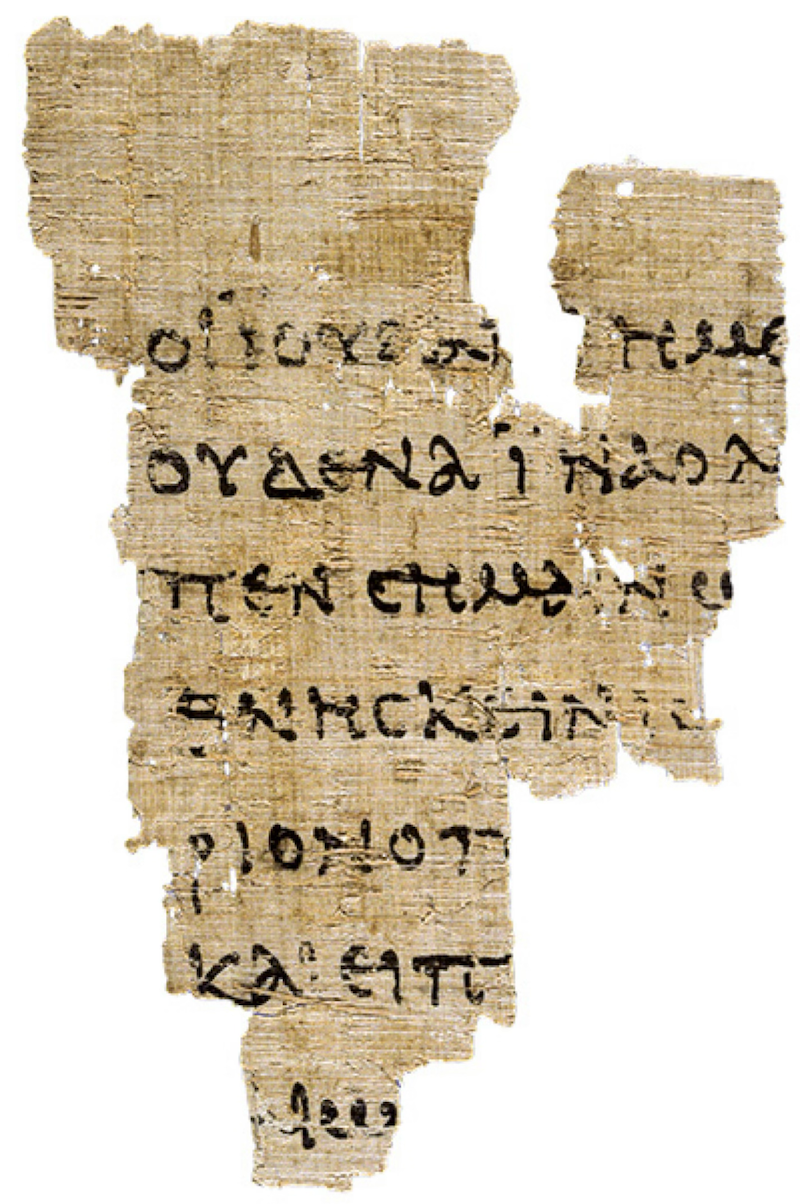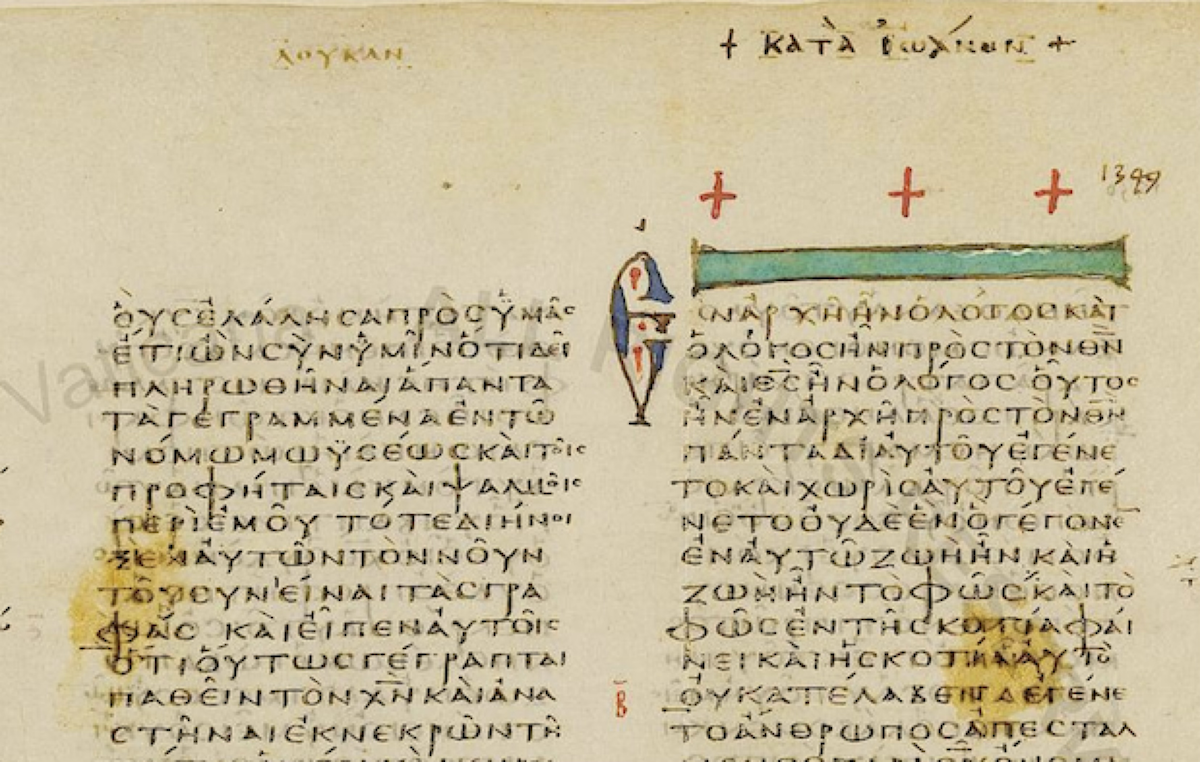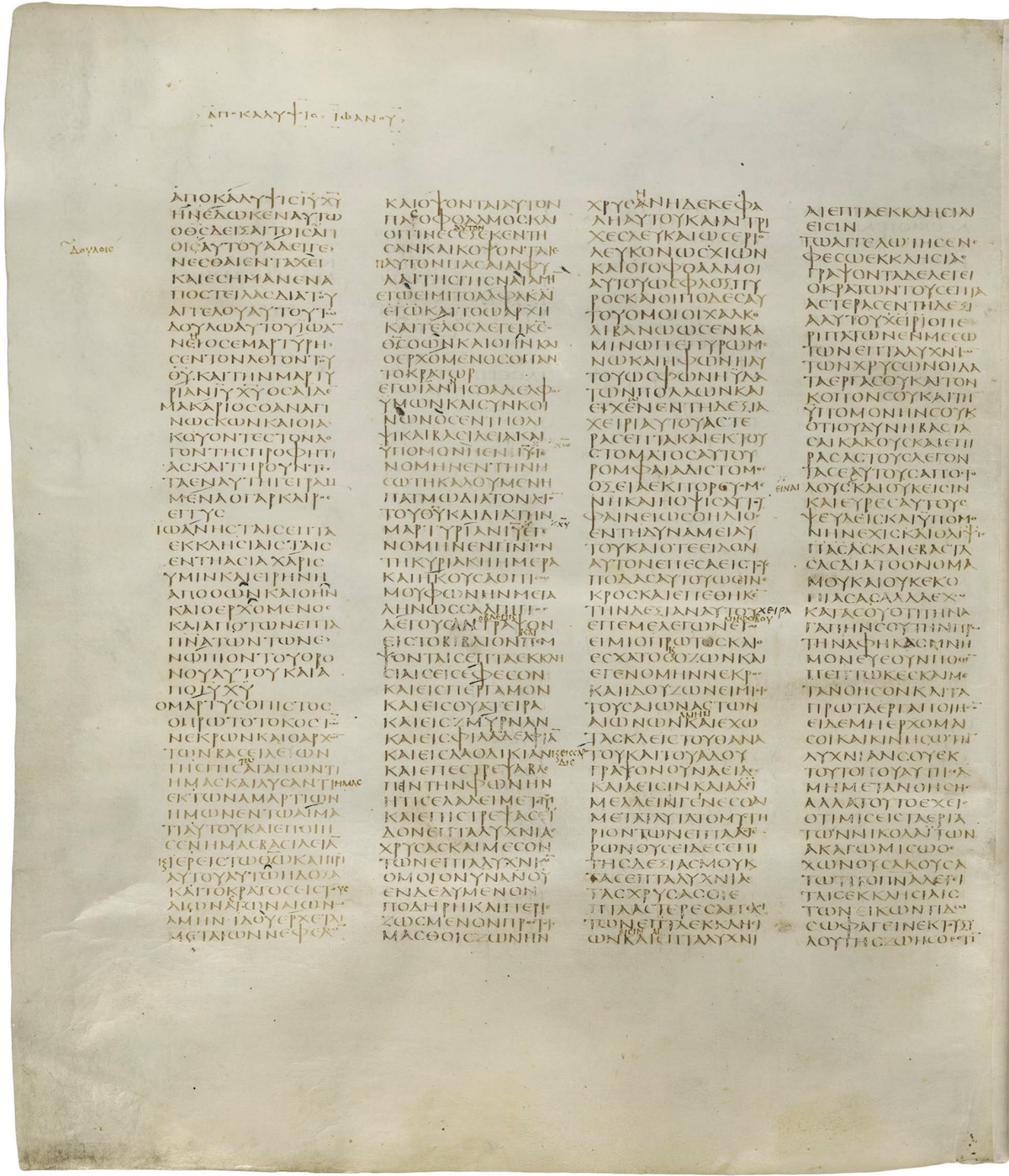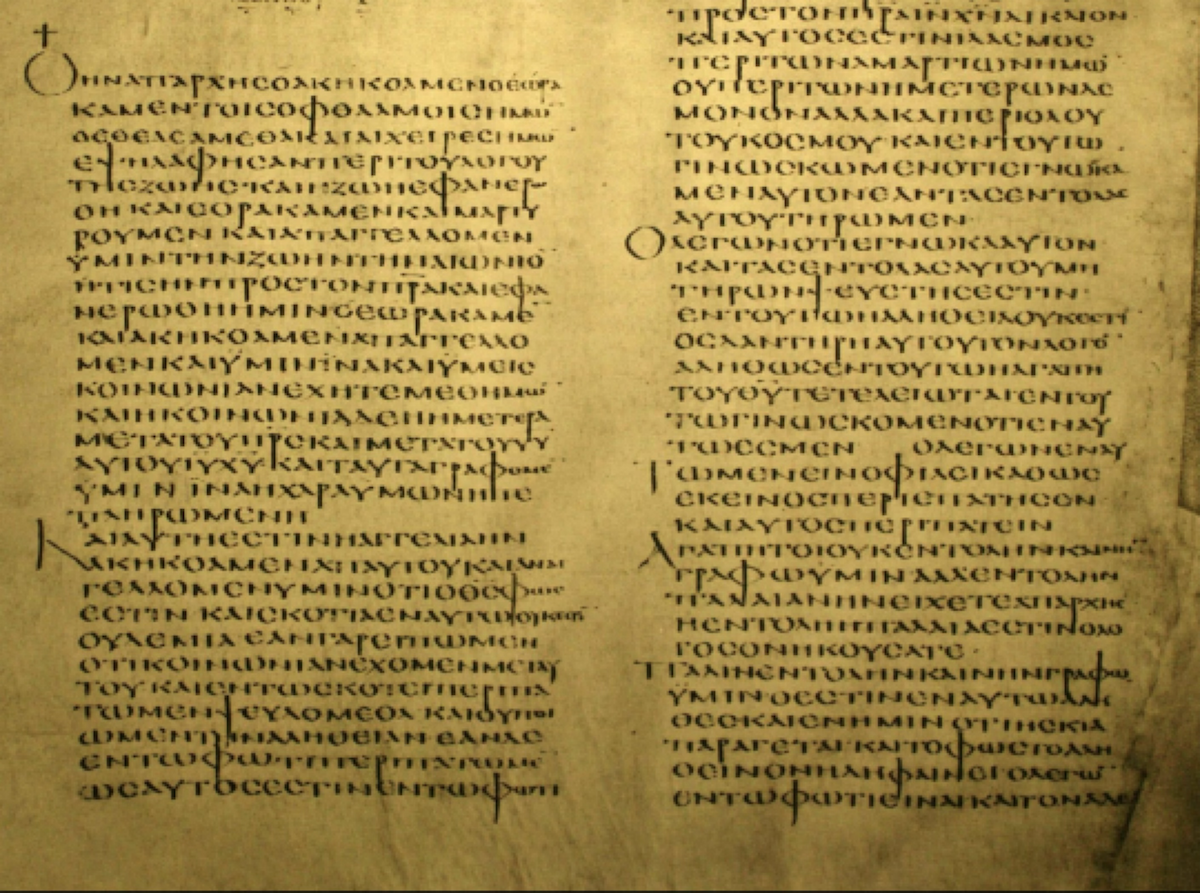
The Text of the New Testament
PDF Notes
PDF Slides
(click to view, right-click to download)
How did the early church preach the Gospel?
The first Christians did NOT have the New Testament for a good part of the 1st century.
How then did they preach the Gospel?
The Septuagint (LXX)
- the Greek translation of the Hebrew Scriptures, completed c. 250 BC in Alexandria by 72 Rabbis.
- Usually abbreviated ‘LXX’ - the Roman numeral for 70
- The Old Testament is called the ‘TaNaKh’ by the Jews - acronym for Torah, Neviim, Ketuvim (Law, Prophets, Writings)
- We understand from this how important the Old Testament is! There is a whole lot of “New Covenant” in the Old Testament
- e.g. Philip proclaiming the Good News to the Ethiopian eunuch in Acts 8 LSB from Isaiah 53 LSB.
- After all Jesus Himself taught from, and expounded upon the TaNaKh
Now He said to them, “These are My words which I spoke to you while I was still with you, that all things which are written about Me in the Law of Moses and the Prophets and the Psalms must be fulfilled.” (Luke 24:44 LSB) For whatever was written in earlier times was written for our instruction, so that through the perseverance and the encouragement of the Scriptures we might have hope. (Romans 15:4 LSB)
Oral Tradition
- Jewish culture was predominantly oral, rather than written
- Writing was a very labor-intensive process, and few could do it
- Scriptures were usually memorized and recited, rather than read
- In the first years of the church after Pentecost, the sayings of Jesus were passed on by word of mouth
- These sayings were eventually compiled and written down in standard forms
Inasmuch as many have undertaken to compile an account of the things that have been fulfilled among us, just as those, who from the beginning were eyewitnesses and servants of the word, handed them down to us, (Luke 1:1-2 LSB)
Enablement of the Holy Spirit
- The Holy Spirit inspired and led the preachers of Gospel, e.g.
- Peter on Pentecost in Acts 2
- Stephen before the Sanhedrin in Acts 7
But the Advocate, the Holy Spirit, whom the Father will send in My name, He will teach you all things, and bring to your remembrance all that I said to you. (John 14:26 LSB)
- New Testament prophets - this is normative
- “Cessationists” say the “extraordinary” gifts have ceased since we now have the New Testament.
Do not quench the Spirit; do not despise prophecies, but examine all things; hold fast to that which is good; (1 Thessalonians 5:19-21 LSB)
- This is not what Paul is talking about here
- Scripture is for all times, places and situations
- The operation of gifts including prophecy is for specific times, places and situations
- We test everything by Scripture - the Holy Spirit does not contradict Himself!
These are not 3 mutually exclusive means, they all three worked together
How the New Testament came to be
The earliest Christians generally believed that the Lord Jesus would return “very soon” – within their lifetimes. Therefore having written records was not considered very important.
As time passed, and some apostles and other witnesses of the resurrection died, it became more important to preserve the Word in writing.
Over a period of several decades, starting about 15 years after the resurrection, the books of the New Testament were written.
Writing was time-consuming and expensive - the books of the New Testament were most often dictated to a professional scribe (amanuensis), rather than written by the author himself. (e.g. Romans 16.22, 1 Peter 5.12)
I, Tertius, who wrote this letter, greet you in the Lord. (Romans 16:22 LSB)
Through Silvanus, our faithful brother as I regard him, I have written to you briefly (1 Peter 5:12 LSB)
The Manuscripts
- “manuscript” means “written by hand” - there were no typewriters
- writing was labor-intensive and quite expensive
- over 5800 Greek manuscripts - the most well-attested ancient text by far - it is not even close
- all are copies of the autographs - no originals
- only very minor variations which are mainly due to copying mistakes
Why did God not allow any of the original autographs to survive?
Scrolls
- all the earliest manuscripts were written on papyrus, a tall, water-loving plant that grows mainly in the Nile Valley in Egypt
- Scrolls of the Torah and other Hebrew Scripture were stored in local synagogues
- limited length of scrolls - hence the length of the Gospels
- not easy to find a place since you could not “flip to a page”
- we read of Jesus reading from the scroll of Isaiah in Luke 4.16-19
He entered the synagogue on the Sabbath and stood up to read. And the scroll of the prophet Isaiah was handed to Him. And He opened the scroll and found the place where it was written, “THE SPIRIT OF THE LORD IS UPON ME, BECAUSE HE ANOINTED ME TO PREACH THE GOSPEL TO THE POOR. HE HAS SENT ME TO PROCLAIM RELEASE TO THE CAPTIVES, AND RECOVERY OF SIGHT TO THE BLIND, TO SET FREE THOSE WHO ARE OPPRESSED, TO PROCLAIM THE FAVORABLE YEAR OF THE LORD.” (Luke 4:16-19 LSB)

Papyrus 52- c. 110-140 - Oldest known papyrus fragment, John 18:31-33
Codices
- mostly written on parchment of vellum, specially cured animal skins
- a “Codex” is pages bound together to make a book - definite improvement on scrolls, as you could now “flip to a page”
- “Codices” is the plural of “Codex”
- “Uncial” means all capital letters, aka. “majuscules”
- No spaces or punctuation marks
- the 3 earliest “Great” Uncial Codices:
- Codex Vaticanus (B) – c. AD 325–350 - Preserves almost the entire Old and New Testament
- Codex Sinaiticus (ℵ, Aleph) – c. AD 330–360 - Contains most of the Old Testament (LXX) and a complete New Testament
- Codex Alexandrinus (A) – c. AD 400–440 - Nearly complete Bible, with some gaps in the New Testament
 Codex Vaticanus - (B) - c. AD 325–350 - End of Luke. Beginning of John
Ἐν ἀρχῇ ἦν ὁ λόγος, καὶ ὁ λόγος ἦν πρὸς τὸν θεόν, καὶ θεὸς ἦν ὁ λόγος.
Codex Vaticanus - (B) - c. AD 325–350 - End of Luke. Beginning of John
Ἐν ἀρχῇ ἦν ὁ λόγος, καὶ ὁ λόγος ἦν πρὸς τὸν θεόν, καὶ θεὸς ἦν ὁ λόγος.
 Codex Sinaiticus - (ℵ, Aleph) – c. AD 330–360 - Revelation 1
Ἀποκάλυψις Ἰησοῦ Χριστοῦ ἣν ἔδωκεν αὐτῷ ὁ θεὸς δεῖξαι τοῖς δούλοις αὐτοῦ ἃ δεῖ γενέσθαι ἐν τάχει
Codex Sinaiticus - (ℵ, Aleph) – c. AD 330–360 - Revelation 1
Ἀποκάλυψις Ἰησοῦ Χριστοῦ ἣν ἔδωκεν αὐτῷ ὁ θεὸς δεῖξαι τοῖς δούλοις αὐτοῦ ἃ δεῖ γενέσθαι ἐν τάχει
 Codex Alexandrinus - (A) – c. AD 400–440 - 1 John 1
Ὃ ἦν ἀπ’ ἀρχῆς, ὃ ἀκηκόαμεν, ὃ ἑωράκαμεν τοῖς ὀφθαλμοῖς ἡμῶν, ὃ ἐθεασάμεθα καὶ αἱ χεῖρες ἡμῶν ἐψηλάφησαν περὶ τοῦ λόγου τῆς ζωῆς
Codex Alexandrinus - (A) – c. AD 400–440 - 1 John 1
Ὃ ἦν ἀπ’ ἀρχῆς, ὃ ἀκηκόαμεν, ὃ ἑωράκαμεν τοῖς ὀφθαλμοῖς ἡμῶν, ὃ ἐθεασάμεθα καὶ αἱ χεῖρες ἡμῶν ἐψηλάφησαν περὶ τοῦ λόγου τῆς ζωῆς
Textual Criticism
- not criticizing the text, but rather finding out what was original
- comparing all the available manuscript evidence
- the science of comparing all the manuscript evidence to determine the original
Four Text Types:
- Alexandrian (Egypt) - concise, oldest, basis of modern Bibles.
- Western (Rome) - looser, paraphasing, early but less precise.
- Byzantine (Byzantium, ) - majority of manuscripts (copies of copies), smoother style, refined, basis of “Majority Text” KJV.
- Caesarean (Caesarea) - possible mixed tradition, not universally accepted.
The Canon
- “Canon” from Greek κανών (kanōn) ‘rule or standard’, as in a measuring rod
- How do we knows which books were accepted as inspired?
- quotations by early church fathers
- translations
- lectionaries
- statements by early church councils - they published lists
- The early Church did not create the Canon, but recognized it.
- we know what it means to recognize the quality of something, e.g.
- a discerning ear can tell a genuine Bach cantata from an attempt by one of his students (No council of music critics got together and decreed that this is a ‘classic’ - it just is.)
- a discerning eye can tell an authentic Rembrandt from a bad imitation
- a discerning palate can tell real hand-made ice cream from a fake “cold dessert” with all kinds of artificial flavors
- This is critically important, because it reveals what is the ultimate authority: The Scripture or The Church
- Compare the Book of Mormon with Scripture
- it is written to sound like Scripture, but it very clearly is not.
- it does not have “the ring of truth”
- The Holy Spirit bears witness with His own words.
- We recognize that Scripture has a special quality
For the word of God is living and active and sharper than any two-edged sword, and piercing as far as the division of soul and spirit, of both joints and marrow, and able to judge the thoughts and intentions of the heart. (Hebrews 4:12 LSB)
Criteria for the Canon
- Recognition over time (no such thing as an “instant classic”)
- Edifying effect on Christians, and universally used
- Agreement with the oral tradition (sayings of Jesus) and the apostles’ teaching, i.e. orthodox
- Apostolic - written either by an apostle, or one in close association with an apostle
Structure
- not chronological in order
- different genres of writing, e.g. letter, narratives, apocalyptic
- wide variety in author’s styles - compare Peter with John and Paul!
- yet agreement in content and purpose!
WLC #4
Q. How doth it appear that the Scriptures are the Word of God? A. The Scriptures manifest themselves to be the Word of God, by their majesty and purity; by the consent of all the parts, and the scope of the whole, which is to give all glory to God; by their light and power to convince and convert sinners, to comfort and build up believers unto salvation: but the Spirit of God bearing witness by and with the Scriptures in the heart of man, is alone able fully to persuade it that they are the very Word of God.
Matthew is the first book in the New Testament. Why? What is a ‘gospel’? Is there more than one?
- The title or superscription in Greek is “According to Matthew”
Answering the skeptic
- The enemies of Jesus would have produced his body
- The disciples were not expecting the resurrection, and yet they all bore witness, and were willing to suffer and die
- This would not have happened if it were an intentional deception
- Unlike those who accused Jesus, the testimony of the apostles all agreed!
- None of his enemies (Pharisees, Priests) were able to refute the claims
- If the account had been made up, it certainly would not have included the witness of women!
- The first witnesses of the resurrection were women
- In Jewish culture, the witness of a woman was not even admissible as evidence in a court of law.
- over 500 living witnesses to the resurrection
For I delivered to you as of first importance what I also received, that Christ died for our sins according to the Scriptures, and that He was buried, and that He was raised on the third day according to the Scriptures, and that He appeared to Cephas, then to the twelve. After that He appeared to more than five hundred brothers at one time, most of whom remain until now, but some have fallen asleep (1 Corinthians 15:3-6 LSB)
The Synoptic Gospels
- “Synoptic” from Greek word “sunopsis” meaning “seen together”
- “Syn” as in synchronize, “Optic” as in “Seeing”
- Similar Content, structure, and tone in the three books of Matthew, Mark and Luke
- Follow a similar geographic sequence of events
- John is quite different: focuses on Jesus in Jerusalem for the feasts
- Many sayings of Jesus in common
- John has many sayings of Jesus which do not occur in the Synoptics
The 2-source theory
- Mark and “Q” are the 2 sources for the material common to Matthew and Luke
- “Q” stands for “Quelle” the German word for “source
- Early church Father Papias (c. AD 95) who heard the apostle John
- quoted by Eusebius in The History of the Church, 3.39 c. AD 315
Ματθαῖος μὲν οὖν Ἑβραΐδι διαλέκτῳ τὰ λόγια συνετάξατο, ἡρμήνευσεν δ᾽ αὐτὰ ὡς ἦν δυνατὸς ἕκαστος.
“Matthew, then, compiled The Sayings in the Hebrew dialect, and each one interpreted them as he was able.”
Assignment
Preparing
- Read chapter 2 of Introducing the New Testament (The Synoptic Gospels)
- Watch Dan Wallace How can you trust the New Testament when the original manuscripts are different? below.
- Watch The Bible Project History of Bible Translation below.
Respond to the following:
Knowing
- What is the name of the Greek translation of the Old Testament used by the apostles to preach the Gospel?
- For how many books of the New Testament do we have originals?
- What is a Codex?
- Which are the 3 “Synoptic Gospels”?
Reflecting
Choose one or two of the following:
- How did the first Christians share the gospel, since they did not have the New Testament?
- By what criteria did the early church recognize which books were inspired and thus to be included in the Canon?
Communicating
You are witnessing to someone in the coffee shop, and he asks you how you can trust the New Testament? How would you respond?
